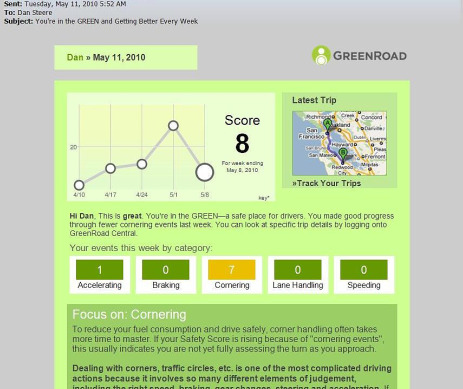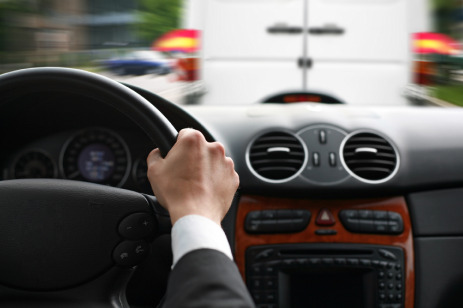I recently took the Chevrolet Volt for a spin near San Francisco’s ballpark, checking another item off my electric-car life list. (Getting to drive pre-production EVs is one fringe benefit of covering green tech.)
Then the other week, I took a drive in another car that promised to help cut greenhouse gas emissions. The car itself was unremarkable — a Lexus RX hybrid that anyone with a spare $42,000 can buy. What was potentially revolutionary was the little black box sitting on the dashboard to the left of the steering wheel.
The box had three lights and when the car’s driver makes a fuel-wasting or dangerous move, such as slamming on the brakes, making fast, sharp turns or weaving through traffic — the LEDs go from green to yellow to red.
See, the problem, dear reader, isn’t just your carbon-spewing car, it’s you.
“There are habits that people fall into that they get away with all the time and by making slight changes in those habits you crash a lot less often and you burn less fuel,” says Dan Steere, chief executive of GreenRoad, a Silicon Valley startup that installs that little black box and other technology in commercial vehicle fleets. GreenRoad is backed by Richard Branson’s Virgin Green Fund and Al Gore’s Generation investment firm.
The road to a sustainable future, in other words, will be paved not just with shiny new gadgets that help cut fossil-fuel consumption, but also by new technology designed to change people’s planet-unfriendly behavior.
“Most of the focus around safety and fuel consumption has been about making a vehicle less lethal when it crashes or inventing entirely new systems like the Volt to try and make the vehicles better,” says Steere. “Ninety percent of crashes are caused by a bad decision the driver made, and the EPA has said that 33 percent of fuel consumption is due to driver behavior.”
GreenRoad attempts to change drivers’ fuel-wasting ways by giving them constant feedback — the little black box — and by sending them weekly emails that analyze their driving and offer tips for improvements.
The payoff for GreenRoad’s corporate customers, according to Steere, is fewer accidents and a lower bill at the pump, all without having to make capital investments in new vehicles.
The GreenRoad system has been installed in more than 80 corporate fleets since 2008. Steere claims some clients have seen accident rates halved and fuel savings of five to 10 percent, depending on the type of vehicles in their fleet. That can translate into annual savings of between $1,000 and $4,000 a vehicle, he notes.
If those numbers bear out, that’s not a bad investment given that GreenRoad charges a subscription fee of about $1,300 per vehicle for a three-year contract.
The potential to cut accident rates has attracted attention from insurers like The Hartford, which have created partnerships with GreenRoad to roll out the technology to their clients.
Steere takes me for a ride through San Francisco to demo the GreenRoad system. Underneath the dashboard there’s another black box which contains sensors and a GPS chip that monitors the car’s speed and movements. On the windshield is a cellular modem and antennas to transmit the data to GreenRoad’s servers.
“It’s patterns we’re looking for,” says Steere as he pulls out into traffic. “As we recognize these events, we create profiles and we send feedback to the driver for different types of coaching and reporting.”
The dashboard box glows green until Steere takes a corner with a burst of acceleration and a sharp turn. Then the yellow light comes on and stays on as he hits the brakes when a jogger enters a crosswalk.
“A lot of people will do things like that but it won’t register in their minds as a problem,” he says. “But we know if you have a habit of doing things like that you’re more likely to crash. So as we recognize patterns of behavior now the key becomes, ‘If we know it and can measure it, how do we help people change their behavior?’ The rest of what we’ve done is to use technology to communicate with people.”
That means the weekly email reports to reinforce what the dashboard box continuously tells the driver.
Steere turns up an alley to show what you need to do to get a red light. He accelerates and slams on the brakes. The box glows red and stays that way for several minutes until Steere demonstrates he’s driving safely again.
 A weekly email report.“We experimented with audio feedback and it turns out that people don’t respond well to that when they’re driving,” he says. “But what turns out to be a really effective thing is that once a week I get an email that says, ‘Dan, way to go you’re a green driver.’ Or, ‘Your score is up a little bit from last week, find out why.”
A weekly email report.“We experimented with audio feedback and it turns out that people don’t respond well to that when they’re driving,” he says. “But what turns out to be a really effective thing is that once a week I get an email that says, ‘Dan, way to go you’re a green driver.’ Or, ‘Your score is up a little bit from last week, find out why.”
It sounds a bit Big Brotherish. But Bob Hutchinson, director of risk management for GreenRoad client MasTec, which installs satellite dish and communications systems, say his employees have embraced the technology.
“They make six to 10 stops a day, and at the end of the day they want to return home safely,” Hutchinson says. “Like any risk manager, you’re always looking to reduce motor vehicle accidents. Of course, if you reduce speed and aggressive driving, you’re going to improve fuel mileage, but it was more about driver safety.”
After a seven-month trial run that ended in December, MasTec installed the GreenRoad technology in 2,900 vehicles. While the company only has three months’ worth of data so far, Hutchinson says accident rates have declined.
“We rolled it out as a driver improvement tool, not a gotcha tool,” he says. “We get a lot of feedback from our drivers who say they’d like to have GreenRoad for their teenagers.”
And that could be a huge potential market for GreenRoad, which is exploring offering the technology to consumers through its insurance company partners.
Now if GreenRoad can just sync your teenager’s GreenRoad real-time driving record to your iPhone, they’ll have a killer app.



